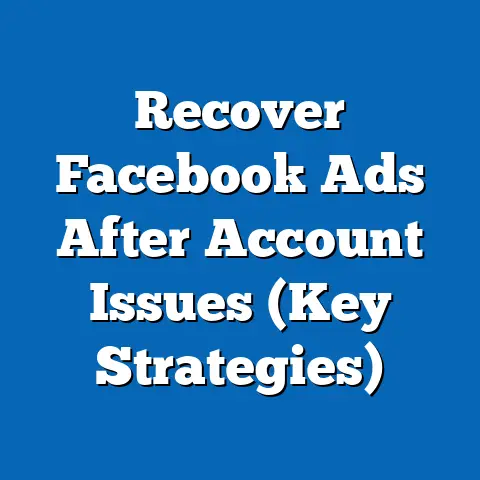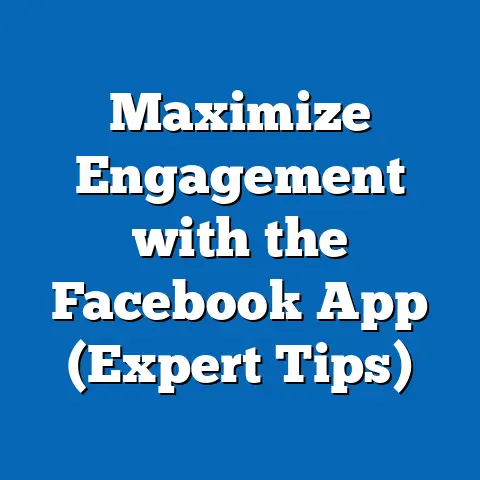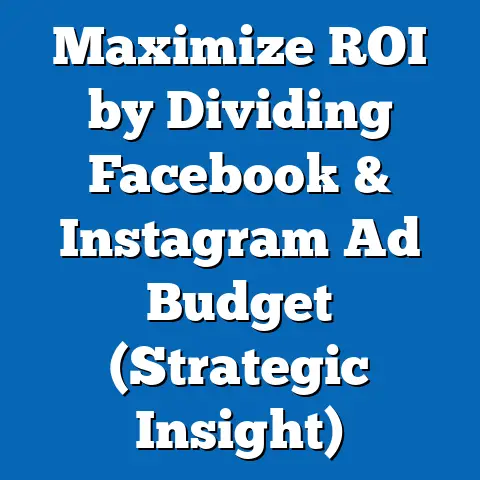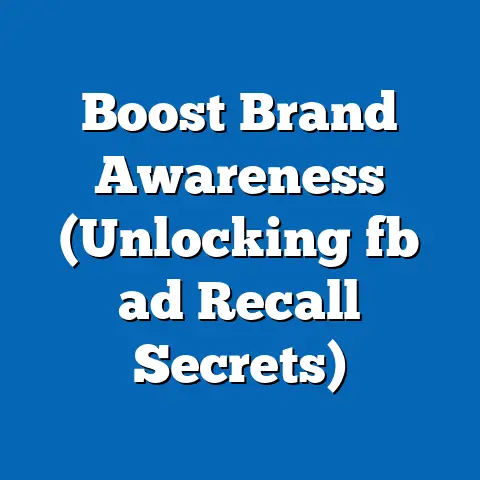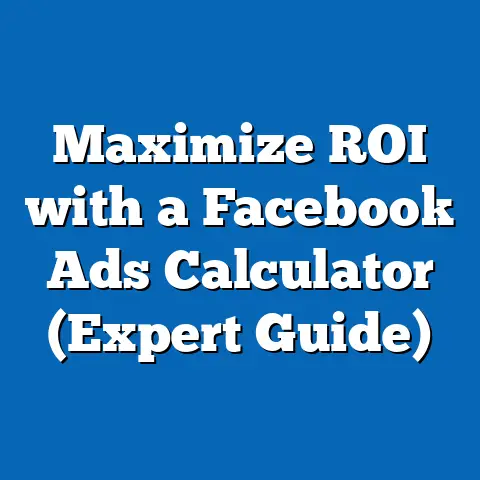Master Facebook Ads Strategically (Expert Learning Path)
The advertising landscape has been utterly revolutionized in recent years. It’s no longer about throwing money at a billboard and hoping for the best. Technological innovations, particularly in the realm of social media, have ushered in an era of unprecedented precision and efficiency. Think about it: machine learning, artificial intelligence, and advanced data analytics are no longer futuristic concepts – they are the bedrock of modern marketing. These advancements have transformed how businesses approach Facebook advertising, enabling them to target audiences with laser-like focus and personalize messaging in ways previously unimaginable. This paradigm shift demands a new breed of marketer, one who not only understands the mechanics of Facebook Ads but also possesses the strategic acumen to leverage its full potential.
I’ve spent years navigating the ever-changing world of Facebook advertising, and I’ve seen firsthand how crucial a strategic approach is. It’s not enough to simply create an ad and hope it resonates. You need a deep understanding of the platform, a clear vision of your goals, and the ability to adapt to constant changes.
That’s why I’ve created this expert learning path. It’s designed to guide you from the fundamentals to advanced strategies, equipping you with the knowledge and skills you need to master Facebook Ads and drive real results for your business. Whether you’re a seasoned marketer looking to refine your skills or a complete beginner eager to dive in, this guide will provide you with the roadmap you need to succeed.
In this article, I’ll take you through a comprehensive journey, covering everything from understanding the Facebook Ads ecosystem to analyzing performance metrics and staying ahead of industry trends. I’ll share my own experiences, insights, and practical tips along the way, so you can avoid common pitfalls and maximize your ROI.
So, buckle up and get ready to embark on your expert learning path. It’s time to unlock the full potential of Facebook Ads and transform your marketing efforts.
Key Takeaway: Mastering Facebook Ads strategically is no longer optional – it’s essential for success in today’s tech-driven marketing environment. This guide provides a comprehensive learning path to equip you with the knowledge and skills you need to thrive.
Section 1: Understanding the Facebook Ads Ecosystem
Before you can even think about creating a winning Facebook ad campaign, you need to understand the playing field. The Facebook Ads ecosystem is complex and multifaceted, but once you grasp its fundamental structure, you’ll be well on your way to navigating it with confidence.
The Facebook Ads ecosystem is structured hierarchically, with three primary levels:
- Campaigns: The highest level, where you define your overall objective (e.g., brand awareness, lead generation, conversions).
- Ad Sets: Within each campaign, you create ad sets, which define your target audience, budget, schedule, and placement.
- Ads: At the lowest level are the individual ads, which consist of the visual (image or video), ad copy, and call-to-action button.
Think of it like this: the campaign is the overall strategy, the ad set is the specific tactic, and the ad is the individual execution. Each level plays a crucial role in determining the success of your campaign.
Different Types of Facebook Ads
Facebook offers a diverse range of ad formats to suit different objectives and target audiences. Here’s a breakdown of some of the most popular options:
- Image Ads: Simple yet effective, image ads are a great way to showcase your product or service with a visually appealing image and concise copy. These are often a good starting point for beginners.
- Video Ads: Video ads are highly engaging and can be used to tell a story, demonstrate a product, or share a testimonial. They’re particularly effective for capturing attention in the busy newsfeed.
- Carousel Ads: Carousel ads allow you to display multiple images or videos within a single ad unit, each with its own headline, description, and link. This format is ideal for showcasing a range of products or highlighting different features of a single product. I’ve seen great success using carousel ads to highlight different angles of a product, or different use-cases for a service.
- Slideshow Ads: Similar to video ads, slideshow ads combine multiple images or videos into a dynamic presentation. They’re a cost-effective alternative to video ads, as they require less production effort.
- Collection Ads: Collection ads are designed for mobile shoppers and feature a main image or video followed by a selection of related products. This format provides a seamless browsing experience and encourages immediate purchases.
- Instant Experience Ads: This is where users click on an ad and are taken to a full-screen experience, without leaving Facebook. This could be a video, a form, or even an interactive game.
Choosing the right ad format depends on your specific objective, target audience, and budget. Experiment with different formats to see what works best for your business.
Navigating the Facebook Ads Manager Interface
The Facebook Ads Manager is your central hub for creating, managing, and analyzing your ad campaigns. It can be a bit overwhelming at first, but once you familiarize yourself with its key features, you’ll be able to navigate it with ease.
Here are some of the most important elements of the Ads Manager:
- Campaign Dashboard: Provides an overview of your active campaigns, including key metrics such as spend, impressions, and results.
- Ad Set Editor: Allows you to define your target audience, budget, schedule, and placement for each ad set.
- Ad Editor: Where you create and customize your individual ads, including the visual, copy, and call-to-action.
- Reporting Dashboard: Provides detailed insights into your campaign performance, including demographics, placements, and conversion data.
- Audiences: Manage your saved audiences, custom audiences, and lookalike audiences.
Take some time to explore the Ads Manager and familiarize yourself with its various features. Facebook offers a wealth of resources and tutorials to help you get started. Don’t be afraid to experiment and try different things – the best way to learn is by doing.
Key Takeaway: Understanding the Facebook Ads ecosystem, including its structure, ad formats, and the Ads Manager interface, is crucial for creating effective and successful campaigns.
Next Step: Take some time to explore the Facebook Ads Manager and familiarize yourself with its various features. Experiment with different ad formats to see what works best for your business.
Section 2: Setting Clear Objectives and Goals
Before you launch your first Facebook ad campaign, it’s absolutely critical to define your objectives and goals. What do you hope to achieve with your advertising efforts? Are you looking to increase brand awareness, generate leads, drive sales, or promote an app?
Setting clear objectives is essential for several reasons:
- It provides direction: Clear objectives give your campaign a sense of purpose and help you stay focused on what matters most.
- It enables measurement: Without clear objectives, it’s impossible to measure the success of your campaign. You need to know what you’re trying to achieve in order to track your progress and make informed adjustments.
- It informs strategy: Your objectives will guide your targeting, ad creative, and bidding strategies.
Campaign Objectives Available on Facebook
Facebook offers a variety of campaign objectives to suit different business needs. Here’s a rundown of some of the most common options:
- Awareness: This objective is designed to reach a broad audience and increase brand recognition. It’s ideal for new businesses or those looking to expand their reach.
- Traffic: This objective is focused on driving traffic to your website or landing page. It’s a good choice if you want to increase website visits or generate leads.
- Engagement: This objective aims to increase engagement with your Facebook page or posts. It’s suitable for businesses looking to build a community and foster relationships with their audience.
- Leads: This objective is designed to collect leads for your business. It’s ideal for businesses that sell high-value products or services that require a sales process.
- App Promotion: This objective is focused on getting people to install and use your app. It’s a good choice for app developers looking to increase their user base.
- Sales: This objective is designed to drive online or offline sales. It’s ideal for e-commerce businesses or those with physical stores.
When choosing a campaign objective, consider your overall business goals and what you hope to achieve with your advertising efforts.
Aligning Business Goals with Facebook Advertising Objectives
Your Facebook advertising objectives should be directly aligned with your overall business goals. For example, if your business goal is to increase sales by 20% in the next quarter, your Facebook advertising objective might be to drive online sales through targeted product ads.
Here’s a simple framework for aligning business goals with Facebook advertising objectives:
- Identify your business goals: What do you want to achieve as a business?
- Determine your marketing goals: How can marketing help you achieve your business goals?
- Define your Facebook advertising objectives: How can Facebook advertising support your marketing goals?
By aligning your business goals with your Facebook advertising objectives, you can ensure that your advertising efforts are contributing to the overall success of your business.
Key Takeaway: Setting clear objectives and aligning them with your business goals is crucial for creating effective and successful Facebook ad campaigns.
Next Step: Define your objectives for your next Facebook ad campaign. What do you hope to achieve? How will you measure your success?
Section 3: Audience Targeting Strategies
One of the most powerful features of Facebook advertising is its sophisticated audience targeting capabilities. Facebook allows you to target your ads to specific demographics, interests, behaviors, and even custom audiences. By leveraging these targeting options, you can ensure that your ads are reaching the people who are most likely to be interested in your product or service.
Demographics, Interests, and Behaviors
Facebook’s demographic targeting options allow you to target your ads based on factors such as age, gender, location, education, and relationship status. This is a great way to reach a broad audience with specific characteristics.
Interest-based targeting allows you to target your ads based on people’s interests, hobbies, and passions. This is a more precise way to reach people who are likely to be interested in your product or service. For instance, if you’re selling running shoes, you can target people who are interested in running, marathons, or fitness.
Behavioral targeting allows you to target your ads based on people’s online behavior, such as their purchase history, website visits, and app usage. This is the most precise way to reach people who are likely to be interested in your product or service. For example, you can target people who have recently visited your website or added items to their shopping cart.
Creating Buyer Personas
Creating buyer personas is a crucial step in developing effective audience targeting strategies. A buyer persona is a semi-fictional representation of your ideal customer, based on research and data about your existing customers.
When creating buyer personas, consider the following factors:
- Demographics: Age, gender, location, education, income, etc.
- Interests: Hobbies, passions, activities, etc.
- Behaviors: Online behavior, purchase history, app usage, etc.
- Pain points: What challenges are they facing? What problems are they trying to solve?
- Goals: What are they trying to achieve? What are their aspirations?
By creating detailed buyer personas, you can gain a deeper understanding of your target audience and tailor your ads to their specific needs and interests.
I once worked with a small business that was struggling to generate leads through Facebook advertising. After conducting thorough research and creating detailed buyer personas, we realized that we were targeting the wrong audience. We adjusted our targeting strategy to focus on people who closely matched our ideal customer profile, and we saw a significant increase in lead generation.
Leveraging Lookalike Audiences and Retargeting
Lookalike audiences and retargeting are two powerful techniques for maximizing ad reach and effectiveness.
Lookalike audiences allow you to reach new people who are similar to your existing customers. Facebook uses its vast database to identify people who share similar demographics, interests, and behaviors with your customer base. This is a great way to expand your reach and acquire new customers who are likely to be interested in your product or service.
Retargeting allows you to show ads to people who have previously interacted with your business, such as visiting your website, adding items to their shopping cart, or watching a video. This is a highly effective way to re-engage potential customers and drive conversions. I’ve found that retargeting ads, when done right, have some of the highest conversion rates.
Key Takeaway: Effective audience targeting is crucial for maximizing the ROI of your Facebook ad campaigns. By leveraging demographics, interests, behaviors, buyer personas, lookalike audiences, and retargeting, you can ensure that your ads are reaching the right people at the right time.
Next Step: Create detailed buyer personas for your target audience. Use these personas to inform your targeting strategies on Facebook. Experiment with lookalike audiences and retargeting to maximize your ad reach and effectiveness.
Section 4: Crafting Compelling Ad Creatives
Even with the most precise targeting in the world, your ads won’t succeed if they don’t capture attention and resonate with your target audience. That’s where compelling ad creatives come in. Your ad creatives – including the visuals, copy, and calls-to-action – are the face of your campaign. They’re what people see first, and they’re what ultimately determine whether someone clicks on your ad or scrolls past it.
The Components of Effective Ad Creatives
Effective ad creatives typically include the following components:
- Visuals: High-quality images or videos that capture attention and convey your message.
- Headline: A concise and attention-grabbing headline that highlights the key benefit of your product or service.
- Description: A brief description that provides more detail about your product or service and encourages people to take action.
- Call-to-action: A clear and compelling call-to-action that tells people what you want them to do (e.g., “Shop Now,” “Learn More,” “Sign Up”).
Each of these components plays a crucial role in attracting attention, conveying your message, and driving conversions.
Best Practices for Designing Eye-Catching Visuals
Your visuals are often the first thing people notice about your ad, so it’s essential to make them eye-catching and relevant to your target audience. Here are some best practices for designing effective visuals:
- Use high-quality images or videos: Avoid blurry or pixelated images.
- Choose visuals that are relevant to your product or service: Make sure your visuals accurately represent what you’re selling.
- Use bright colors and bold designs: Capture attention and stand out from the crowd.
- Showcase your product in action: Demonstrate how your product works or how it can benefit the user.
- Use human faces: People are naturally drawn to faces, so including a human face in your visual can increase engagement.
Writing Compelling Ad Copy that Resonates
Your ad copy should be concise, clear, and compelling. It should highlight the key benefits of your product or service and encourage people to take action. Here are some tips for writing effective ad copy:
- Know your audience: Understand their needs, interests, and pain points.
- Focus on benefits, not features: Explain how your product or service can solve their problems or improve their lives.
- Use strong verbs and action words: Encourage people to take action.
- Keep it short and sweet: Get to the point quickly and avoid jargon.
- Include a clear call-to-action: Tell people what you want them to do.
Examples of Successful Facebook Ads
Let’s take a look at some examples of successful Facebook ads and analyze what makes them effective:
- Example 1: Dollar Shave Club: Dollar Shave Club uses humor and relatable language in their ad copy to grab attention and highlight the convenience of their subscription service. The visuals are simple yet effective, showcasing their product in a straightforward manner.
- Example 2: Airbnb: Airbnb uses stunning visuals of unique accommodations to inspire wanderlust and encourage people to book their next vacation. The ad copy highlights the benefits of using Airbnb, such as finding unique places to stay and saving money.
- Example 3: Skillshare: Skillshare uses targeted ads to reach people who are interested in learning new skills. The ad copy highlights the wide range of courses available on their platform and encourages people to sign up for a free trial.
These examples demonstrate the power of compelling ad creatives in driving engagement and conversions.
Key Takeaway: Compelling ad creatives are essential for capturing attention, conveying your message, and driving conversions on Facebook. By following best practices for designing visuals and writing copy, you can create ads that resonate with your target audience and achieve your advertising goals.
Next Step: Review your existing Facebook ads. Are your visuals eye-catching and relevant? Is your ad copy concise, clear, and compelling? Are you using a clear call-to-action? Make adjustments as needed to improve the effectiveness of your ads.
Section 5: Budgeting and Bidding Strategies
Setting the right budget and choosing the right bidding strategy are crucial for maximizing the ROI of your Facebook ad campaigns. Too little budget, and your ads won’t reach enough people. Too much budget, and you’ll waste money on ineffective targeting. Similarly, the wrong bidding strategy can lead to either overspending or underexposure.
Budgeting Options for Facebook Ads
Facebook offers two primary budgeting options:
- Daily Budget: Allows you to set a fixed amount that you’re willing to spend each day on your ad campaign. This is a good option for beginners or those who want to control their spending closely.
- Lifetime Budget: Allows you to set a total amount that you’re willing to spend over the entire duration of your ad campaign. This is a good option for campaigns with a specific end date or those who want to maximize their reach within a fixed budget.
When choosing a budgeting option, consider your campaign objectives, target audience, and overall budget.
Bidding Strategies Explained
Facebook offers a variety of bidding strategies to suit different campaign objectives and budgets. Here are some of the most common options:
- Lowest Cost: This bidding strategy aims to get you the most results for your budget. Facebook automatically adjusts your bids to maximize the number of clicks, impressions, or conversions you receive. This is a good option for beginners or those who want to maximize their reach.
- Cost Cap: This bidding strategy allows you to set a target cost per result (e.g., cost per click, cost per conversion). Facebook will then try to get you as many results as possible while staying within your target cost. This is a good option for those who have a specific cost target in mind.
- Target Cost: This bidding strategy aims to get you results as close as possible to your target cost. Facebook will adjust your bids to try to achieve your target cost, but it may not always be possible. This is a good option for those who have a specific cost target in mind and are willing to be flexible.
- Bid Cap: This bidding strategy allows you to set a maximum bid that Facebook can use for each auction. This is a good option for those who want to control their spending closely and avoid overbidding.
- Manual Bidding: This bidding strategy gives you complete control over your bids. You can manually set your bids for each auction, allowing you to fine-tune your spending and maximize your ROI. This option requires a more advanced understanding of the Facebook Ads platform and is generally not recommended for beginners.
Optimizing Ad Spend for Maximum ROI
Optimizing your ad spend is crucial for maximizing the ROI of your Facebook ad campaigns. Here are some tips for optimizing your ad spend:
- Monitor your campaign performance closely: Track your key performance indicators (KPIs) such as click-through rates (CTR), conversion rates, and cost per acquisition (CPA).
- A/B test different ad creatives and targeting options: Experiment with different variations of your ads to see what works best.
- Adjust your bids based on performance: Increase your bids for ads that are performing well and decrease your bids for ads that are underperforming.
- Pause or remove underperforming ads: Don’t be afraid to cut your losses and focus on the ads that are driving results.
- Refine your targeting: Make sure you’re targeting the right audience with the right message.
Key Takeaway: Setting the right budget and choosing the right bidding strategy are crucial for maximizing the ROI of your Facebook ad campaigns. By understanding the different budgeting options and bidding strategies available, and by optimizing your ad spend based on performance, you can ensure that you’re getting the most bang for your buck.
Next Step: Review your current Facebook ad campaigns. Are you using the right budgeting option and bidding strategy? Are you optimizing your ad spend based on performance? Make adjustments as needed to improve your ROI.
Section 6: Analyzing Performance Metrics
Creating a Facebook ad campaign is only half the battle. The real magic happens when you start analyzing your performance metrics and using those insights to optimize your campaigns for better results. Without a deep understanding of your key performance indicators (KPIs), you’re essentially flying blind.
Key Performance Indicators (KPIs) to Monitor
There are several key performance indicators (KPIs) that marketers should monitor to track the success of their Facebook ad campaigns. Here are some of the most important ones:
- Impressions: The number of times your ad was displayed.
- Reach: The number of unique people who saw your ad.
- Click-Through Rate (CTR): The percentage of people who clicked on your ad after seeing it. A higher CTR indicates that your ad is relevant and engaging to your target audience.
- Conversion Rate: The percentage of people who completed a desired action (e.g., making a purchase, filling out a form) after clicking on your ad.
- Cost Per Click (CPC): The average cost you paid for each click on your ad.
- Cost Per Acquisition (CPA): The average cost you paid for each conversion.
- Return on Ad Spend (ROAS): The amount of revenue you generated for every dollar you spent on advertising.
By monitoring these KPIs, you can gain a clear understanding of how your campaigns are performing and identify areas for improvement.
Using Facebook Analytics and Ads Manager to Track Performance
Facebook Analytics and Ads Manager provide a wealth of data and insights that you can use to track your campaign performance.
Facebook Analytics allows you to track user behavior on your website or app, providing valuable insights into how people are interacting with your content. You can use this data to understand your target audience, identify popular content, and optimize your website or app for better engagement.
Ads Manager provides detailed reporting on your Facebook ad campaigns, including metrics such as impressions, reach, CTR, conversion rates, and cost per acquisition. You can use this data to track your campaign performance, identify underperforming ads, and optimize your targeting and bidding strategies.
The Importance of A/B Testing
A/B testing is a crucial technique for optimizing your Facebook ad campaigns. It involves creating two or more variations of your ads (e.g., different visuals, headlines, or descriptions) and testing them against each other to see which one performs best.
By A/B testing different ad variations, you can identify the most effective elements of your ads and optimize your campaigns for better results. I’ve found that even small changes in your ad creative or targeting can have a significant impact on your campaign performance.
Key Takeaway: Analyzing performance metrics is crucial for optimizing your Facebook ad campaigns and maximizing your ROI. By monitoring key performance indicators (KPIs), using Facebook Analytics and Ads Manager to track performance, and conducting A/B testing, you can gain valuable insights into what’s working and what’s not, and make informed adjustments to improve your results.
Next Step: Set up Facebook Analytics and connect it to your website or app. Start tracking your campaign performance in Ads Manager and identify areas for improvement. Begin A/B testing different ad variations to optimize your campaigns for better results.
Section 7: Staying Ahead of Trends and Changes
The world of Facebook advertising is constantly evolving. New features, algorithms, and best practices are introduced regularly, so it’s essential to stay updated on the latest trends and changes. What worked yesterday may not work today, so continuous learning and adaptation are crucial for long-term success.
The Ever-Evolving Nature of Facebook Advertising
Facebook is constantly updating its platform and algorithm, which can have a significant impact on your ad campaigns. For example, changes to Facebook’s targeting options or ad delivery system can affect your reach, cost per click, and conversion rates.
It’s important to stay informed about these changes and adjust your strategies accordingly. Follow industry blogs, attend webinars, and join online communities to stay up-to-date on the latest trends and best practices.
I remember one instance where Facebook changed its algorithm, and our ad campaigns suddenly started performing poorly. We quickly adapted by adjusting our targeting and bidding strategies, and we were able to recover our performance within a few days. This experience taught me the importance of being agile and adaptable in the face of change.
Resources for Ongoing Learning
There are numerous resources available to help you stay updated on the latest trends and changes in Facebook advertising. Here are some of the most valuable options:
- Facebook’s Official Resources: Facebook provides a wealth of resources for advertisers, including its Help Center, Business Blog, and Blueprint courses. These resources are a great way to learn about new features, best practices, and case studies.
- Industry Blogs: Numerous industry blogs cover Facebook advertising, including Social Media Examiner, AdEspresso, and Jon Loomer Digital. These blogs provide valuable insights, tips, and tutorials on a variety of topics.
- Webinars and Online Courses: Many organizations offer webinars and online courses on Facebook advertising. These courses provide in-depth training on specific topics and can help you develop your skills and knowledge.
- Industry Publications: Industry publications such as MarketingProfs, Ad Age, and Adweek often cover Facebook advertising trends and news.
- Online Communities and Forums: Joining online communities and forums such as the Facebook Ads Experts Community and the Digital Marketing Subreddit can provide valuable opportunities to connect with other marketers, share experiences, and ask questions.
Joining Communities and Forums
Joining communities and forums can be a great way to connect with other marketers, share experiences, and ask questions. These communities can provide valuable support and guidance as you navigate the ever-changing world of Facebook advertising.
I’ve learned a lot from participating in online communities and forums. I’ve been able to connect with other marketers, share my experiences, and learn from their successes and failures. These communities have been invaluable in helping me stay updated on the latest trends and best practices.
Key Takeaway: Staying ahead of trends and changes is crucial for long-term success in Facebook advertising. By staying informed about platform updates, algorithm changes, and industry best practices, and by continuously learning and adapting your strategies, you can ensure that your campaigns remain effective and achieve your desired results.
Next Step: Subscribe to industry blogs, attend webinars, and join online communities to stay updated on the latest trends and changes in Facebook advertising. Make a habit of reviewing your campaigns regularly and adjusting your strategies as needed.
Conclusion
Mastering Facebook Ads strategically is no longer a luxury – it’s a necessity for businesses that want to thrive in today’s competitive digital landscape. The platform’s ever-evolving nature demands a proactive and adaptable approach, one that combines a deep understanding of the ecosystem with a commitment to continuous learning.
Remember, the journey to becoming a Facebook Ads expert is an ongoing process. Embrace the challenges, stay curious, and never stop learning. By applying the knowledge and strategies discussed in this article, you can embark on your expert learning path and effectively enhance your Facebook advertising efforts.
The key takeaways from this article include:
- Understanding the Facebook Ads ecosystem is crucial for creating effective campaigns.
- Setting clear objectives and aligning them with your business goals is essential for measuring success.
- Effective audience targeting is crucial for maximizing your ROI.
- Compelling ad creatives are essential for capturing attention and driving conversions.
- Setting the right budget and choosing the right bidding strategy are crucial for maximizing your ROI.
- Analyzing performance metrics is crucial for optimizing your campaigns and improving your results.
- Staying ahead of trends and changes is crucial for long-term success.
As you embark on your Facebook advertising journey, remember that consistency and persistence are key. Don’t be afraid to experiment, test new strategies, and learn from your mistakes. With dedication and a strategic mindset, you can master Facebook Ads and achieve your business goals.
Now, it’s time to put your newfound knowledge into action. Start by reviewing your existing campaigns and identifying areas for improvement. Experiment with different targeting options, ad creatives, and bidding strategies. Track your results closely and make adjustments as needed.
The world of Facebook advertising is constantly evolving, so it’s important to stay updated on the latest trends and best practices. Subscribe to industry blogs, attend webinars, and join online communities to stay informed and connected.
By embracing a strategic approach and continuously learning, you can master Facebook Ads and drive real results for your business. Good luck on your journey!


